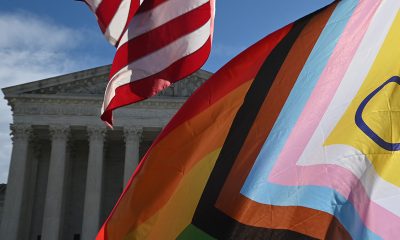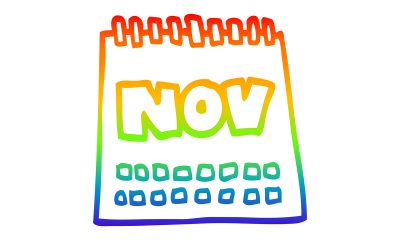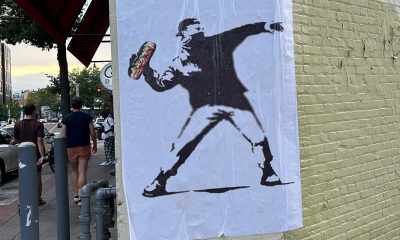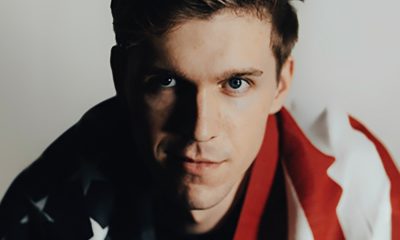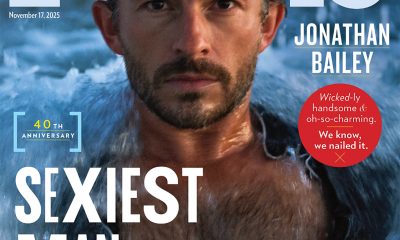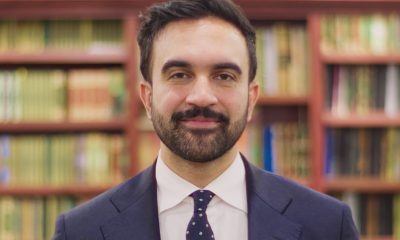District of Columbia
Capital Pride Festival wows with surprise appearances
Harris speaks, Symone struts as celebrations return
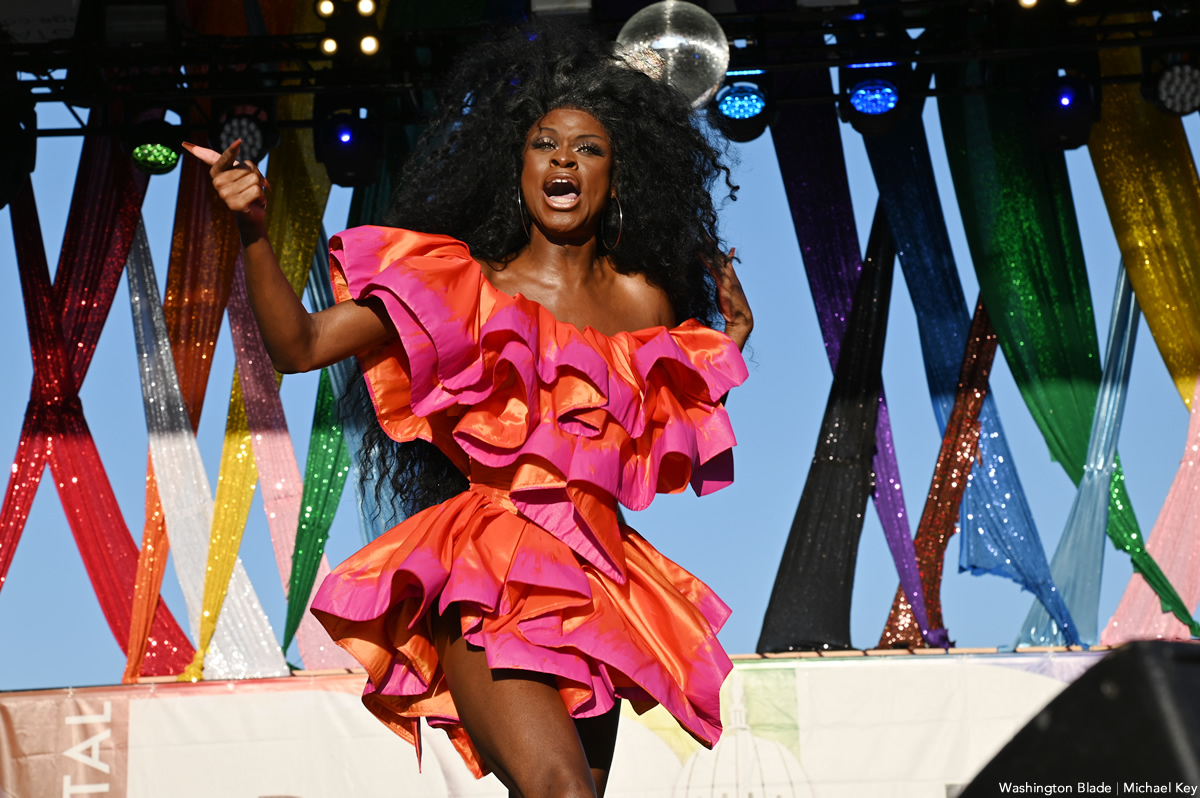
Amid a roster of weekend Pride festivities in the nation’s capital that ended with a much-anticipated performance from pop band DNCE, Vice President Kamala Harris marched onto the Capital Pride Festival stage Sunday afternoon — as the crowd roared in surprise — to stress the importance of queer rights and rebuke white supremacy.
“No one should fear going to a nightclub for fear that a terrorist might try to take them down,” she said in reference to the Pulse nightclub shooting of 2016 in Orlando, Fla. “No one should fear going to a Pride celebration because of the white supremacists,” she added.
Harris also referenced recent legislation in southern states like Texas and Florida that inhibits children’s self-expression.
“Our children in Texas and Florida shouldn’t fear who they are,” she said.
Harris was joined on stage by second gentleman Douglas Emhoff and RuPaul’s Drag Race season 13 winner Symone.
The Washington Blade scored an exclusive interview with Symone after the vice president’s remarks.
Symone, who stood about six feet tall in a pair of beige-colored stilettos and a bejeweled turquoise leotard that she would later exchange for a blood orange-and-fuschia layered frill mini-dress, mentioned that Capital Pride was her first Pride event of the season.
“It feels great to be back amongst family,” she said. “It feels good to see all the love and excitement.”
Drawing on about a year since her win on “Drag Race,” the drag queen — affectionately known by her fans as the “Ebony Enchantress” — said that her drag has evolved into the special moments outside of her performances where she can “take care of people [around her].”
“I can finally give back to my mom,” she said.
With regards to her artistic approach to the art form, Symone emphasized that drag is a form of self-expression that allows her to be the most authentic part of herself and to say what she wants to say.
In her season, she celebrated Black culture and Black beauty by draping her head with sculptural braided Black hairstyles and giving nods to streetstyle, including through an outfit that included a meters-long durag.
In one of her season’s runway categories, she strutted in a white gown and fascinator with the phrase, “Say their names” emblazoned on the back. This was in protest of police brutality.
When looking to the future of her profession, Symone is gleeful because she says that more people will become comfortable with drag because it exists to “give joy, laughter, and love.”
“I think what people have left out is that [drag] is art at the end of the day,” she said. “It has always been this art form to play with.”
Her statement echoed one that Harris made earlier: “No one should fear who they love.”
After the interview, Symone returned to Capital Pride’s stage in a waist-length curly black wig to dance to Diana Ross’s “I’m Coming Out” and Beyonce’s “Apeshit,” all while exposing her slender, toned, and glossed legs that brought gasps from some audience members.
Symone’s performance and Harris’s speech were part of the last leg of events that ended a festival that saw hundreds of LGBTQ-friendly organizations, bars and clubs, and food vendors staff booths on Pennsylvania Avenue.
The National Association for the Advancement of Colored People was in attendance for the first time and gave out T-shirts that read “Black Pride” and encouraged passersby to contact their senators to pass the Equality Act — legislation that prohibits discrimination based on gender and sexual orientation. The Equality Act was passed in the U.S. House of Representatives in 2021 and has been stalled in the U.S. Senate since.
“We want to make sure that our [leaders] are doing what we need them to do,” said Annalise Setorie, director of partnerships at the NAACP. Setorie is also chair of the LGBTQ taskforce.
“[The NAACP] fights for all the rights of Black people so we are here to support and uplift the Black queer community,” she added.
District of Columbia
‘Sandwich guy’ not guilty in assault case
Sean Charles Dunn faced misdemeanor charge
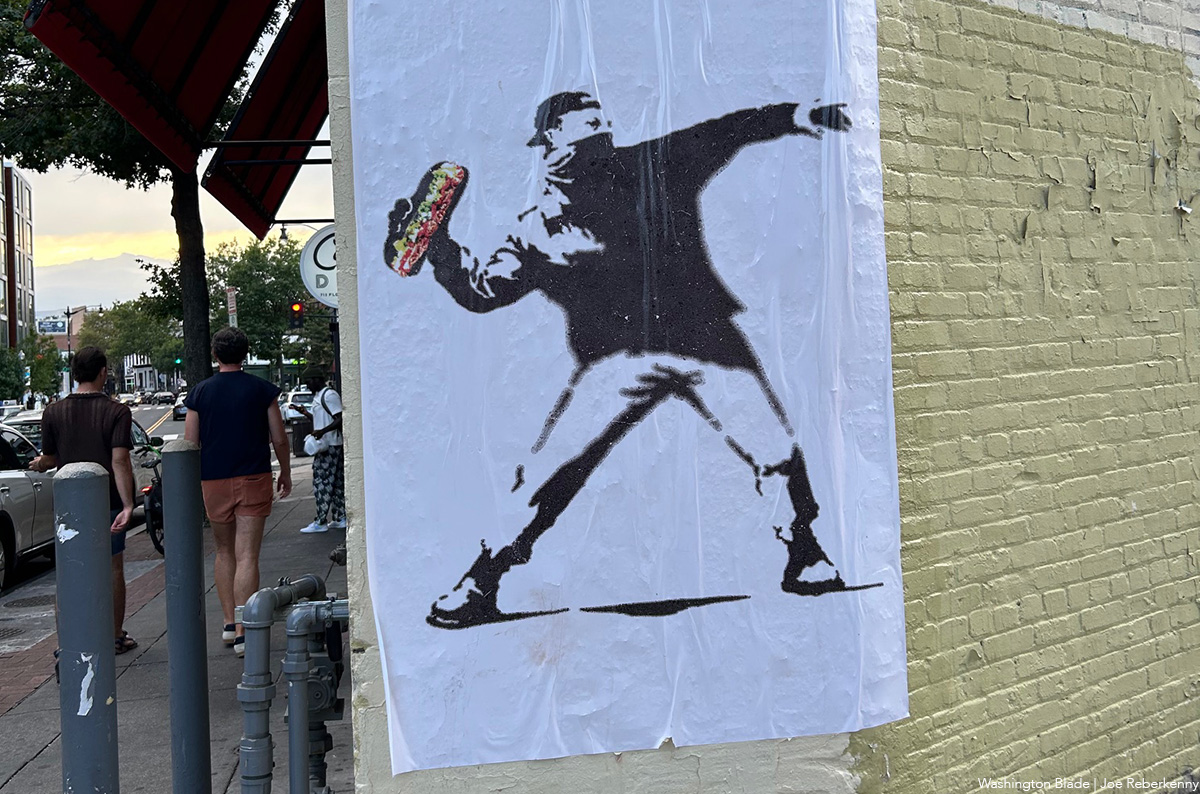
A jury with the U.S. District Court for the District of Columbia on Thursday, Nov. 6, found D.C. resident Sean Charles Dunn not guilty of assault for tossing a hero sandwich into the chest of a U.S. Customs and Border Protection agent at the intersection of 14th and U streets, N.W. at around 11 p.m. on Aug. 10.
Dunn’s attorneys hailed the verdict as a gesture of support for Dunn’s contention that his action, which was captured on video that went viral on social media, was an exercise of his First Amendment right to protest the federal border agent’s participating in President Donald Trump’s deployment of federal troops on D.C. streets.
Friends of Dunn have said that shortly before the sandwich tossing incident took place Dunn had been at the nearby gay nightclub Bunker, which was hosting a Latin dance party called Tropicoqueta. Sabrina Shroff, one of three attorneys representing Dunn at the trial, said during the trial after Dunn left the nightclub he went to the submarine sandwich shop on 14th Street at the corner of U Street, where he saw the border patrol agent and other law enforcement officers standing in front of the shop.
Shroff and others who know Dunn have said he was fearful that the border agent outside the sub shop and immigrant agents might raid the Bunker Latin night event. Bunker’s entrance is on U Street just around the corner from the sub shop where the federal agents were standing.
“I am so happy that justice prevails in spite of everything happening,“ Dunn told reporters outside the courthouse after the verdict while joined by his attorneys. “And that night I believed that I was protecting the rights of immigrants,” he said.
“And let us not forget that the great seal of the United States says, E Pluribus Unum,” he continued. “That means from many, one. Every life matters no matter where you came from, no matter how you got here, no matter how you identify, you have the right to live a life that is free.”
The verdict followed a two-day trial with testimony by just two witnesses, U.S. Customs and Border Protection agent Gregory Lairmore, who identified Dunn as the person who threw the sandwich at his chest, and Metro Transit Police Detective Daina Henry, who told the jury she witnessed Dunn toss the sandwich at Lairmore while shouting obscenities.
Shroff told the jury Dunn was exercising his First Amendment right to protest and that the tossing of the sandwich at Lairmore, who was wearing a bulletproof vest, did not constitute an assault under the federal assault law to which Dunn was charged, among other things, because the federal agent was not injured.
Prosecutors with the Office of the U.S. Attorney for D.C. initially attempted to obtain a grand jury indictment of Dunn on a felony assault charge. But the grand jury refused to hand down an indictment on that charge, court records show. Prosecutors then filed a criminal complaint against Dunn on the misdemeanor charge of assaulting, resisting, or impeding certain officers of the United States.
“Dunn stood within inches of Victim 1,” the criminal complaint states, “pointing his finger in Victim 1’s face, and yelled, Fuck you! You fucking fascists! Why are you here? I don’t want you in my city!”
The complaint continues by stating, “An Instagram video recorded by an observer captured the incident. The video depicts Dunn screaming at V-1 within inches of his face for several seconds before winding his arm back and forcefully throwing a sub-style sandwich at V-1.
Prosecutors repeatedly played the video of the incident for the jurors on video screens in the courtroom.
Dunn, who chose not to testify at his trial, and his attorneys have not disputed the obvious evidence that Dunn threw the sandwich that hit Lairmore in the chest. Lead defense attorney Shroff and co-defense attorneys Julia Gatto and Nicholas Silverman argued that Dunn’s action did not constitute an assault under the legal definition of common law assault in the federal assault statute.
Assistant U.S. Attorney Michael DiLorenzo, the lead prosecutor in the case, strongly disputed that claim, citing various provisions in the law and appeals court rulings that he claimed upheld his and the government’s contention that an “assault” can take place even if a victim is not injured as well as if there was no physical contact between the victim and an alleged assailant, only a threat of physical contact and injury.
The dispute over the intricacies of the assault law and whether Dunn’s action reached the level of an assault under the law dominated the two-day trial, with U.S. District Court Judge Carl J. Nichols, who presided over the trial, weighing in with his own interpretation of the assault statute. Among other things, he said it would be up to the jury to decide whether or not Dunn committed an assault.
Court observers have said in cases like this, a jury could have issued a so-called “nullification” verdict in which they acquit a defendant even though they believe he or she committed the offense in question because they believe the charge is unjust. The other possibility, observers say, is the jury believed the defense was right in claiming a law was not violated.
DiLorenzo and his two co-prosecutors in the case declined to comment in response to requests by reporters following the verdict.
“We really want to thank the jury for having sent back an affirmation that his sentiment is not just tolerated but it is legal, it is welcome,” defense attorney Shroff said in referring to Dunn’s actions. “And we thank them very much for that verdict,” she said.
Dunn thanked his attorneys for providing what he called excellent representation “and for offering all of their services pro bono,” meaning free of charge.
Dunn, an Air Force veteran who later worked as an international affairs specialist at the U.S. Department of Justice, was fired from that job by DOJ officials after his arrest for the sandwich tossing incident.
“I would like to thank family and friends and strangers for all of their support, whether it was emotional, or spiritual, or artistic, or financial,” he told the gathering outside the courthouse. “To the people that opened their hearts and homes to me, I am eternally grateful.”
“As always, we accept a jury’s verdict; that is the system within which we function,” CNN quoted U.S. Attorney for D.C. Jeanine Pirro as saying after the verdict in the Dunn case. “However, law enforcement should never be subjected to assault, no matter how ‘minor,’” Pirro told CNN in a statement.
“Even children know when they are angry, they are not allowed to throw objects at one another,” CNN quoted her as saying.
District of Columbia
Trial begins for man charged with throwing sandwich at federal agent
Jury views video of incident that went viral on social media

Prosecutors showed jurors a video of Sean Charles Dunn throwing a sub sandwich into the chest of a U.S. Customs and Border Protection agent at the bustling intersection of 14th and U streets, N.W. at around 11 p.m. on Aug. 10 of this year on the opening day of Dunn’s trial that has drawn national attention.
According to a knowledgeable source, Dunn threw the sandwich at the agent after shouting obscenities at him and other federal law enforcement officers who were stationed at that location after he was refused admission to the nearby gay bar Bunker for being too intoxicated.
Charging documents and reports by witnesses show that Dunn expressed outrage that the federal officers were stationed there and at other locations in D.C. under orders from President Donald Trump to help curtail crime in the city.
Prosecutors with the Office of the U.S. Attorney for D.C. initially attempted to obtain a grand jury indictment of Dunn on a felony assault charge, but the grand jury refused to hand down an indictment on that charge, court records show. Prosecutors then filed a criminal complaint against Dunn on the misdemeanor charge of assaulting, resisting, or impeding certain officers of the United States.
“Dunn stood within inches of Victim 1,” a criminal complaint states, “pointed his finger in Victim 1’s face, and yelled, Fuck you! You fucking fascists! Why are you here? I don’t want you in my city!”
The complaint adds, “Dunn continued his conduct for several minutes before crossing the street and continuing to yell obscenities at V-1. At approximately 11:06 p.m. Dunn approached V-1 and threw a sandwich at him, striking V-1 in the chest.”
The complaint continues by stating, “An Instagram video recorded by an observer captured the incident. The video depicts Dunn screaming at V-1 within inches of his face for several seconds before winding his arm back and forcefully throwing a sub-style sandwich at V-1.”
At the opening day of testimony at the trial on Tuesday, Nov. 4, V-1, who was identified as Customs and Border Patrol Agent Gregory Lairmore, testified as the first government witness. Also testifying was Metro Transit Police Detective Daina Henry, who said she was present at the scene and saw Dunn throw the sandwich at Lairmore.
The position taken by Dunn’s defense attorneys is outlined in a 24-page memorandum in support of a motion filed on Oct. 15 calling for the dismissal of the case, which was denied by U.S. District Court Judge Carl J. Nichols.
“This prosecution is a blatant abuse of power,” the defense memo states. “The federal government has chosen to bring a criminal case over conduct so minor it would be comical – were it not for the unmistakable retaliatory motive behind it and the resulting risk to Mr. Dunn.”
It adds, “Mr. Dunn tossed a sandwich at a fully armed, heavily protected Customs and Border Protection {CBP} officer. That act alone would never have drawn a federal charge. What did was the political speech that accompanied it.”
The trial was scheduled to resume at 9 a.m. on Wednesday, Nov. 5.
District of Columbia
D.C. mayor announces use of local funds for SNAP food aid
Md., Va. arrange for similar local replacement of federal money
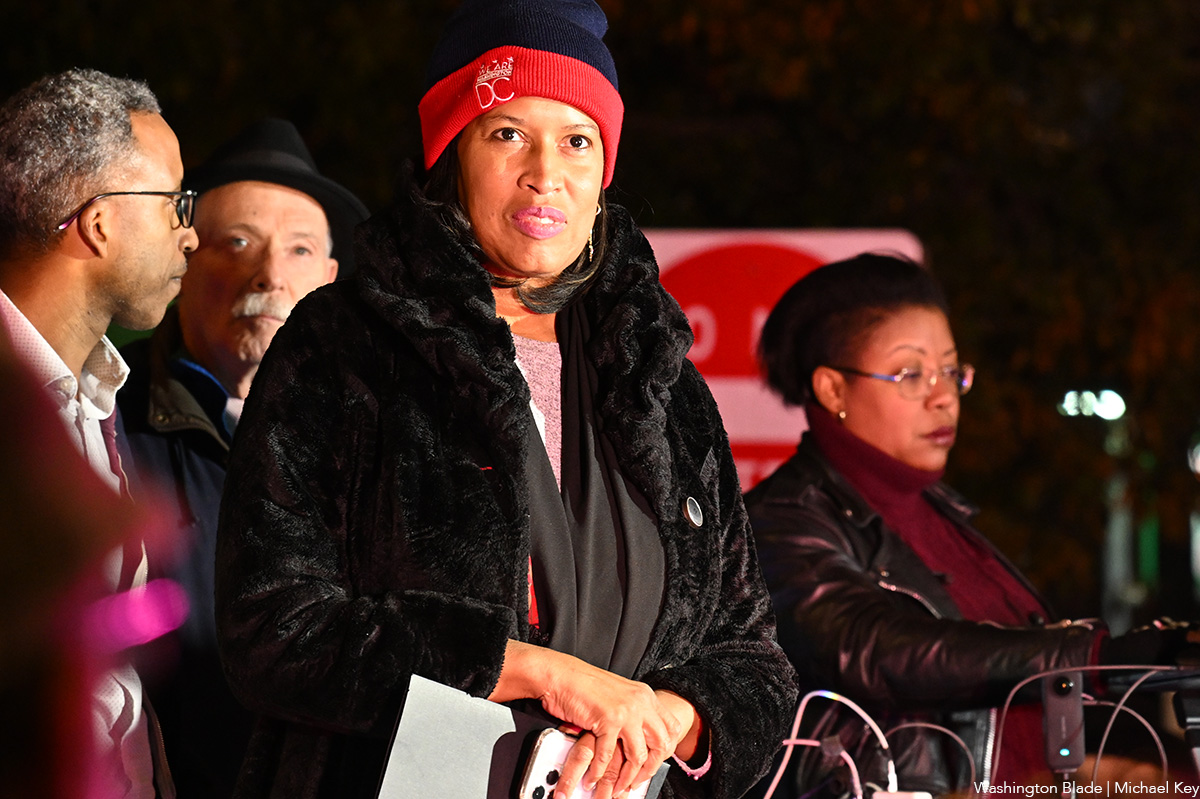
D.C. Mayor Muriel Bowser announced on Oct. 30 that she has arranged for at least $129 million in local D.C funds to be used to support as many as 141,000 D.C. residents in need who depend on the federal food assistance programs known as SNAP and WIC whose funding will be cut off beginning Nov. 1 due to the federal shutdown.
SNAP, which stands for the Supplemental Nutrition Assistance Program, and WIC, the Women, Infants, and Children Program, provide food related services for 10 million or more people in need nationwide.
Maryland Gov. Wes Moore, Virginia Gov. Glenn Youngkin, and Delaware Gov. Matt Meyer also announced similar plans to provide emergency state funds to replace the federal funds cut off beginning Nov. 1 for the two food programs.
Similar to Bowser, Moore and Youngkin said their replacement funds at this time would only last for the month of November. Each said they were hopeful that Congress would end the shutdown before the end of November.
“We know that SNAP and WIC play a critical role in keeping thousands of Washingtonians and millions of Americans put food on the table each month,” Bowser said in a statement. “We were hopeful it wouldn’t come to this – and we will need the federal government to reopen as soon as possible – but for right now, we’re moving forward to ensure we take care of D.C. residents in November,” she said.
The mayor’s statement says about 85,000 D.C. households, consisting of 141,000 individuals, receive SNAP support each month, with an average monthly allocation of $314. It says more than 12,500 city residents in 8,300 households benefit from the WIC program.
A spokesperson for the D.C. Mayor’s Office of LGBTQ Affairs couldn’t immediately be reached to determine whether the city has an estimated count of how many LGBTQ residents receive support from the SNAP and SIC programs.
-

 District of Columbia1 day ago
District of Columbia1 day ago‘Sandwich guy’ not guilty in assault case
-

 Sports2 days ago
Sports2 days agoGay speedskater racing toward a more inclusive future in sports
-

 Celebrity News4 days ago
Celebrity News4 days agoJonathan Bailey is People’s first openly gay ‘Sexiest Man Alive’
-

 Opinions5 days ago
Opinions5 days agoNew York City mayoral race gets nasty but Mamdani will win

